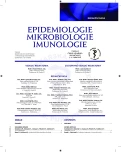-
Medical journals
- Career
The prevalence of Candida pelliculosa, Candida utilis, and Candida fabianii in the Olomouc University Hospital: epidemiological study
Authors: L. Svobodová 1; D. Bednářová 2; P. Hamal 1
Authors‘ workplace: Ústav mikrobiologie Lékařské fakulty Univerzity Palackého a Fakultní nemocnice Olomouc 1; GeneProof, a. s., Brno 2
Published in: Epidemiol. Mikrobiol. Imunol. 65, 2016, č. 1, s. 34-38
Category: Original Papers
Overview
Background:
The aims of this study were to determine the prevalence of C. pelliculosa, C. utilis, and C. fabianii in clinical samples collected from patients hospitalized in the Olomouc University Hospital and compare their minimum inhibitory concentrations (MICs ) to nine systemic antifungals with respect to yeast species, patient age, gender, and site of infection.Material and Methods:
Identification was performed biochemically and using mass spectrometry (MALDI-TOF MS). MICs were determined by the broth dilution method.Results:
Of a total of 163 clinical isolates, 119 were biochemically identified as C. pelliculosa and 44 as C. utilis. Using MALDI-TOF MS, 152 isolates were identified as C. fabianii, six as C. pelliculosa, three as C. utilis, and one as Ogataea polymorpha. The highest mean MICs were found in C. fabianii and in yeasts isolated from blood cultures and central venous catheters.Conclusions:
The MALDI-TOF MS found C. fabianii to be most prevalent in clinical samples as compared with the other studied species. The probable cause of discordant results between the two methods was the absence of C. fabianii in the database of the biochemical test kit which led to misidentification of this species. Higher MIC values in C. fabianii demonstrate the importance of the precise identification of this species.Keywords:
Candida fabianii – epidemiology – identification – MALDI-TOF – antifungals
Sources
1. Nguyen MH, Peacock JE, Morris AJ, et al. The changing face of candidemia: emergence of non-Candida albicans species and antifungal resistance. Am J Med, 1996;100(6):617–623.
2. Chow JK, Golan Y, Ruthazer R, et al. Factors associated with candidemia caused by non-albicans Candida species versus Candida albicans in the intensive care unit. Clin Infect Dis, 2008;46(8):1206–1213.
3. Krcmery V, Barnes AJ. Non-albicans Candida spp. causing fungaemia: pathogenicity and antifungal resistance. J Hosp Infect, 2002;50(4):243–260.
4. Hachem R, Hanna H, Kontoyiannis D, et al. The changing epidemiology of invasive candidiasis. Cancer, 2008;112(11):2493–2499.
5. Trofa D, Gácser A, Nosanchuk JD. Candida parapsilosis, an emerging fungal pathogen. Clin Microbiol Rev, 2008;21(4):606–625.
6. Enwuru CA, Ogunledun A, Idika N, et al. Fluconazole resistant opportunistic oropharyngeal Candida and non-Candida yeast-like isolates from HIV infected patients attending ARV clinics in Lagos, Nigeria. Afr Health Sci, 2008;8(3):142–148.
7. Redding SW, Kirkpatrick WR, Dib O, et al. The epidemiology of non-albicans Candida in oropharyngeal candidiasis in HIV patients. Spec Care Dentist, 2000;20(5):178–181.
8. Nicolatou-Galitis O, Velegraki A, Sotiropoulou-Lontou A, et al. Effect of fluconazole antifungal prophylaxis on oral mucositis in head and neck cancer patients receiving radiotherapy. Support Care Cancer, 2006;14(1):44–51.
9. Haber J, Jesenská Z, Krčméry V, et al. Systémové mykózy a jejich léčba. Praha: Galén; 1995.
10. Dendis M, Horváth R, Michálek J, et al. PCR-RFLP detection and species identification of fungal pathogens in patients with febrile neutropenia. Clin Microbiol Infect, 2003;9(12):1191–1202.
11. Kurtzman CP, Fell JW. The yeasts, a taxonomic study. Amsterdam: Elsevier Science BV; 1998.
12. Limtong S, Kaewwichian R, Yongmanitchai W, et al. Diversity of culturable yeasts in phylloplane of sugarcane in Thailand and their capability to produce indole-3-acetic acid. World J Microbiol Biotechnol, 2014;30(6):1785–1796.
13. Romo-Sánchez S, Alves-Baffi M, Arévalo-Villena M, et al. Yeast biodiversity from oleic ecosystems: study of their biotechnological properties. Food Microbiol, 2010;27(4):487–492.
14. Dooley DP, Beckius ML, McAllister CK, et al. Prostatitis caused by Hansenula fabianii. J Infect Dis, 1990;161(5):1040–1041.
15. Bhally HS, Jain S, Shields C, et al. Infection in a neonate caused by Pichia fabianii: importance of molecular identification. Med Mycol, 2006;44(2):185–187.
16. Valenza G, Valenza R, Brederlau J, et al. Identification of Candida fabianii as a cause of lethal septicaemia. Mycoses, 2006;49(4):331–334.
17. Hamal P, Ostransky J, Dendis M, et al. A case of endocarditis caused by the yeast Pichia fabianii with biofilm production and developed in vitro resistance to azoles in the course of antifungal treatment. Med Mycol, 2008;46(6):601–605.
18. Grenouillet F, Millon L, Chamouine A, et al. Pichia fabianii fungemia in a neonate. Pediatr Infect Dis J, 2010;29(2):191.
19. Gabriel F, Noel T, Accoceberry I. Lindnera (Pichia) fabianii blood infection after mesenteric ischemia. Med Mycol, 2012;50(3):310–314.
20. Yun JW, Park KS, Ki CS, et al. Catheter-related bloodstream infection by Lindnera fabianii in a neutropenic patient. J Med Microbiol, 2013;62(6):922–925.
21. Wu Y, Wang J, Li W, et al. Pichia fabianii blood infection in a premature infant in China: case report. BMC Research Notes, 2013;6 : 77.
Labels
Hygiene and epidemiology Medical virology Clinical microbiology
Article was published inEpidemiology, Microbiology, Immunology

2016 Issue 1-
All articles in this issue
- The prevalence of Candida pelliculosa, Candida utilis, and Candida fabianii in the Olomouc University Hospital: epidemiological study
- The benefit from mumps virus IgG antibody avidity testing in the population with high vaccine coverage in the context of other serological methods for laboratory diagnosis of mumps and the current epidemiological
- Assessment of invalidity as a result of infectious diseases
- Infectious and other somatic comorbidity in problem drug users – results of a cross-sectional study with medical examination
- Hepatitidis E virus
- Antibiotic treatment of clostridial colitis
- Prevalence of infectious complications in burn patients requiring intensive care: data from a pan-European study
- Influenza in the pediatric population in Istanbul: a one center experience 2009–2014
- Epidemiology, Microbiology, Immunology
- Journal archive
- Current issue
- Online only
- About the journal
Most read in this issue- Antibiotic treatment of clostridial colitis
- Infectious and other somatic comorbidity in problem drug users – results of a cross-sectional study with medical examination
- Hepatitidis E virus
- Assessment of invalidity as a result of infectious diseases
Login#ADS_BOTTOM_SCRIPTS#Forgotten passwordEnter the email address that you registered with. We will send you instructions on how to set a new password.
- Career

